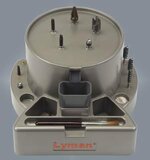- Messages
- 4,129
- Reactions
- 2,198
I have not tried the LNL. The Dillon is tried and true for sure.
I have 2 of the RCBS 2000's and really like them. I got the first in the "kit" version for $299. I think they had it mis-marked because at the time most were selling it around $400 but I asked and that is what they wanted for it. I decided I needed a second progressive for when I was doing a lot of reloading of 2 different calibers this makes much easier change over. The only logical choice was another RCBS because I had all the pieces for it. Even with that I have had no real problems to speak of that were not operator error. I would have no reservations about buying another.
I can do about 4-500 rounds per hour pretty easy.
I have 2 of the RCBS 2000's and really like them. I got the first in the "kit" version for $299. I think they had it mis-marked because at the time most were selling it around $400 but I asked and that is what they wanted for it. I decided I needed a second progressive for when I was doing a lot of reloading of 2 different calibers this makes much easier change over. The only logical choice was another RCBS because I had all the pieces for it. Even with that I have had no real problems to speak of that were not operator error. I would have no reservations about buying another.
I can do about 4-500 rounds per hour pretty easy.













